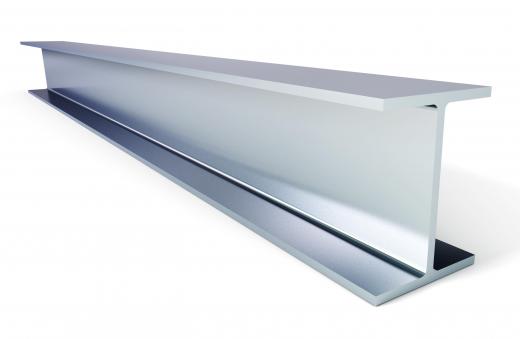Structural steel is used in bridges, buildings and other types of structures throughout the world. During its manufacture, the steel is fabricated to suit a project's applicable specifications such as strength, chemical composition and shape. The main ingredients in structural steel are iron and carbon. Common additives found in addition to the iron and carbon are manganese, alloys and certain chemicals, which improve its strength and durability.
Steel is the product of mixing iron with carbon. When it is formed into particular shapes and sizes, it is referred to as structural steel. The I-beam is the most common type used today. Skyscrapers, stadiums and the ship building industry all incorporate some type of I-beam construction.

Various shapes, sizes and gauges can be formed out of structural steel. Common shapes include the I-beam, channels, and angles. Once manufactured, the steel is cut to length according to the project's specifications. Other forms of structural steel include rolled sheets and flat plates.
This material requires specialized equipment to cut, drill and fabricate it to applicable specifications. The steel is cut into lengths most often using a typical bandsaw. Another tool used to cut the steel into lengths or to cut irregular openings is a cutting torch. For highly specialized projects, the proper specifications are programmed into a computerized CNC coping machine. Holes are drilled into the the steel using a CNC beam drill line, which automatically feeds it along conveyors while also aligning it in the proper position for drilling.

Advantages to using structural steel are that it is inexpensive to manufacture, requires less maintenance, and is cheaper to insure than other traditional building methods. As long as it is protected from rust, the steel maintains its strength indefinitely. Another advantage to using structural steel is that it can be recycled. Disadvantages include higher transportation costs due to its weight, and that without proper maintenance, it is prone to rust or corrosion. It also requires large amounts of energy to produce.

Some examples of famous landmarks made using structural steel include the Seagram Building, the Eiffel Tower, and the Brooklyn Bridge. The Seagram Building carries the distinction of being one of the most well-engineered buildings in the world. Completed in 1889, the Eiffel Tower in Paris, France is probably the most famous steel structure in the world. The Brooklyn Bridge, completed in 1883, spans the East River in New York. The bridge connects Brooklyn to Manhattan and is a United States National Historic Landmark.
